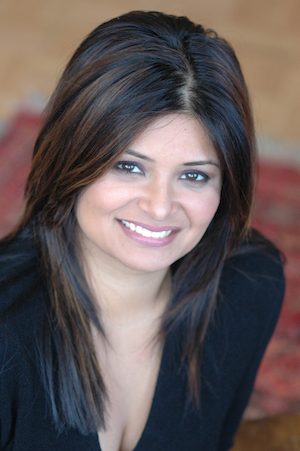Joya Dass is a first generation South Asian, born to immigrant parents who came from Calcutta and Myanmar. Growing up in Pennsylvania, she learned about bharatnatyam dance and making poori. She also learned that women didn’t have a voice or decision-making power. Ironically, today she makes her living with her voice as a television anchor. She has spent 15 years interviewing Fortune 500 CEOs and is now working to empower South Asian women entrepreneurs to overcome cultural roadblocks and help them realize their personal and professional self.
Joya Dass – Television anchor, public speaker, co-founder of LadyDrinks, executive director of South Asian International Film Festival. Tell us more about yourself and what you do? What experiences most shaped who you are today?
I wear many hats, but today I inhabit three main avatars: I am a television anchor. I have delivered business news from the floor of the New York Stock Exchange for the last 15 years of my career for CNN, Bloomberg, ABC, CBS. Currently, you can see me anchoring for a New York Station NY1. For the last 13 years, I also have been the host of a weekly Saturday morning entertainment show that highlights all the upcoming attractions from the Indian film industry or Bollywood. It’s called AVS.
In 2009, I started my own documentary production company. My first feature length film was centered on the topics of curable blindness in children in India. The film became a fundraising vehicle for the Sankara Eye Foundation. Each year subsequent, I’ve taken on one large project. For three years, I was engaged by the Rockefeller Foundation to produce and direct a series of mini documentaries on their philanthropic work. I directed a series of photo essays on South Asian survivors of domestic violence for Sakhi for South Asian women. In 2014, I was also named Executive Director of a film festival, presented by HBO.
The platform I’m most associated with today is co-founder of a women’s networking initiative called Lady Drinks. It works to champion the South Asian female entrepreneurs.
A little bit about my family background. My mother, a native of Calcutta (now Kolkata), and my dad, originally from Burma (now Myanmar), had an arranged marriage. It was mismatch from day one. My mom was raised in a very wealthy family. It was in an era and time when my mom was very keen to get out of India. My father bootstrapped his way out of a very poor existence and made his way to the US. It was a tough match because they came from distinctly different backgrounds.
I remember growing up with the intimate knowledge that everything patently “American” was scary to them. Even more so because I was a girl. So I led a pretty strict and uncompromising upbringing. I remember growing up wanting to be able to go and play outside but I had to stay inside till 6pm because my mom did not want me to get dark. Going to dances, proms, camps was forbidden for me because I was a girl and I would be vulnerable to who knows what.
I was forever hearing “Girls don’t do this and girls don’t do that”. Meanwhile, all I wanted to be was ‘normal.’ Go to the mall. Eat ice cream with my friends. Go to the movies. Be a cheerleader. Join choir. I saw my brother growing up with very different rules. With me, there was always this fear, will she get pregnant and will she get violated if she goes out with boys.
College was a lot of things for me. But it was also the first time I got to make decisions for myself. I’d say that was a critical juncture and was a huge part of why I am a journalist today.
Why did you want to become a journalist? You did not have any contacts or support in the industry when you started out. What challenges did you face and how did you overcome them? What kept you motivated? Any episodes of stereotyping or discrimination you want to talk about?
Every night, as a family, we would sit and watch NBC Nightly News. I would sit by my dad’s legs on the floor, grab every 8×10 piece of paper I could find in the house, and spread them around the coffee table so I could look as industrious and as importantly messy as Tom Brokaw. I never understood why my ‘coffee table come desk’ didn’t look as messy as his.
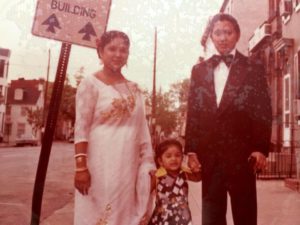
Joya with her parents
I think my mom picked up my proclivity towards writing and journalism early on. She would scour the newspapers everyday looking for writing contests and essay contests to enter me into. She really worked to nurture that skillset in me. However, when I left for college, my dad was pretty clear about my future: I was going to become a doctor. And my mother didn’t have a say in the matter.
I learned early on, women in my home didn’t have a voice about a lot of important stuff. But becoming a journalist was really important to me. Even when my parents exited stage left, and I was left to my own devices to pay for a very expensive private school education. But you know what? I did it. I also was a product of a home of domestic violence; so at the time when I was busy getting through college, it was because I had this forward momentum. I was damned if I was going to return to the home dynamic I left behind. My credo: Always keep moving forward. Nose to the grindstone. Don’t look back. I paid for college. I also knew I had no contact in the industry and the only way I could establish them was by going to graduate school for journalism.
I chose Boston University, which had a 3 semester graduate curriculum from which I would matriculate readily employable. I would graduate being able to shoot, edit, and put together a newscast. Graduate school and the contacts I made there helped me get my first four jobs in the industry.
Pros of TV journalism – I do something very specific. I deliver business news. The camera comes on and you have to just be able to talk. No prompter. No script. I have at my fingertips, a series of screens with information about the major indexes, gold, oil, and headlines. I have to be able to synthesize information on the spot. I love the math, science, technology that goes into explaining why a company did well last quarter or why not.
Cons of TV journalism – TV journalism has changed a lot since I first started out, so it’s a bit of a cut-throat business. It is a very superficial industry. It’s a lot about the smarts, but it’s also about the looks. People perennially comment about my weight, and if its up or down. The hours can be very tough. For many years, I was up at 2:30am, into work by 3:30am and on the air by 5am. That got me very sick and it was at the cost of my personal life. I worked many holidays. I don’t do that anymore. People think TV is a glamorous profession, but there is a whole way of life that exists behind that glass screen that is not so.
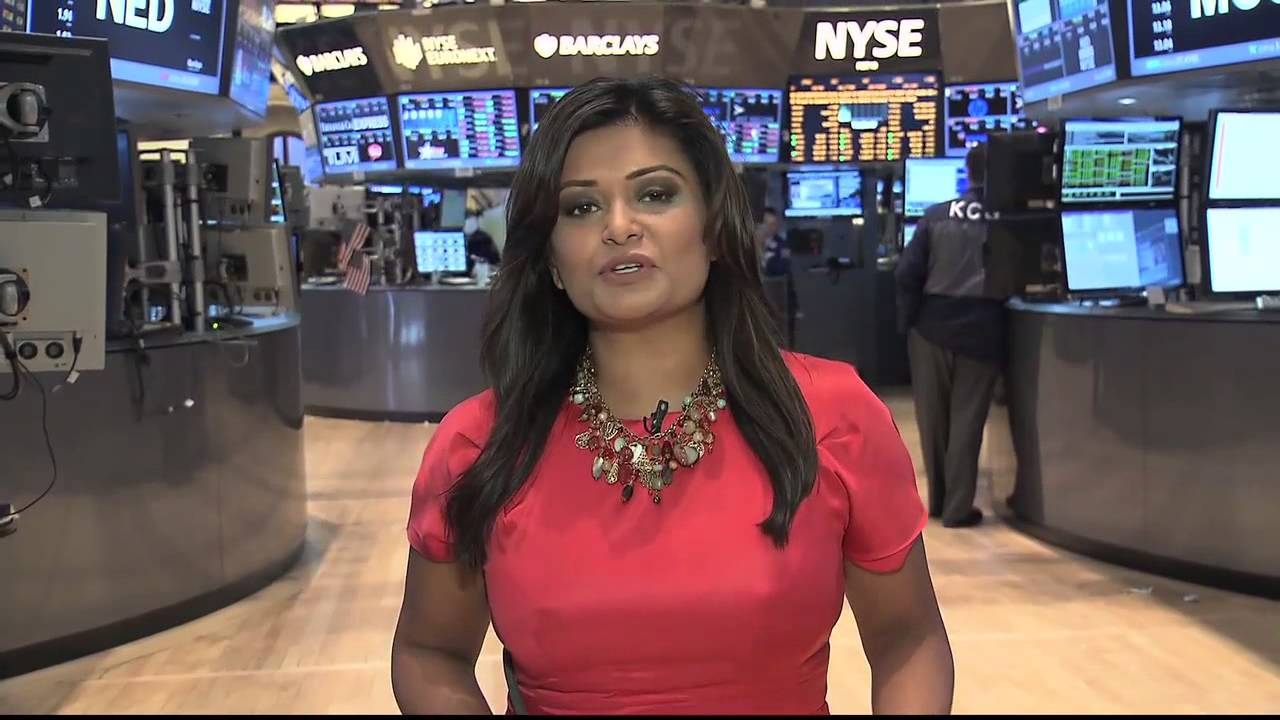
Delivering business news
Anyone sitting on the hiring side of television will tell you that it’s a casting call. There will be one Asian or one African American on a news anchoring team. Rarely two. It has worked to my advantage that people can’t place me as Indian. I look like a lot of ethnicities, and favor mainstream facial traits. I’d say the first time I experienced any sort of real gender discrimination was when I became Executive Director of the Film Festival I helmed last year. I am always my straight forward no nonsense, no bullshit self. And I’d hear the men around me be that way. But I would be labeled as being ‘bossy’ or told to tone it down in my interactions. It’s funny, because with my women’s initiative, I talk about this stuff all the time. And then it was happening to me in real time.
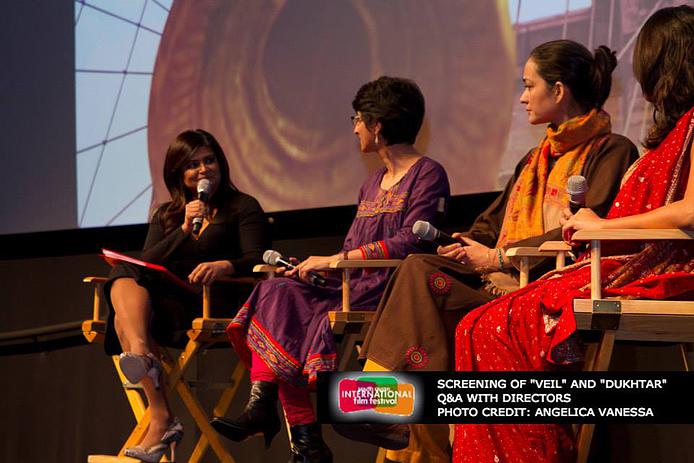
You come from a home of domestic violence . Talk about the impact it had on you as a child, mentally and emotionally. Most women are unable to get away due to lack of financial freedom. You chose to cut ties with both your parents quickly – Why?
I am what social workers would term a “secondary survivor”. My mom was the primary survivor. Growing up in a house of domestic violence has its downside. It took me a long time to develop my voice. I didn’t have a blueprint of what a good relationship between a man and a woman should look like. What respect for a partner looks like. (At 41, I feel I do now.) The dynamic at home made me a master at “shutting things off” as a kid and carrying on with my day. After an incident, I would still go to school. Always moving forward. I did not experience any physical violence but there was a mental aspect of it which one experiences till much later. I think it has its ripple effect down the line. So even till this day, when something goes wrong or someone wrongs me I know that I will always get by, because I will keep moving forward.
Having grown up in a house of domestic violence, affected my relationships. Whenever I was in a relationship I was choosing less than what I deserved because I just did not know any better. I didn’t know that a man and woman could be in a healthy dynamic with each other and it could be a blissful union. I think I was mimicking the dynamic I saw at home. Now I finally know what a good relationship means and what respect is within the confines of a good relationship and I am still looking for that person.
My mom has this quiet strength to put her head down and keep going. I think she tried to protect us in the best way that she knew how. I think she was dealing with a lot of trauma herself and that drove a wedge between us. She is still wired in the traditional Indian mold and totally financially dependent on my father, even though they have since separated. On the other hand, I would live on $3.00 a day, if it meant I had freedom to make my own choices. As a result, for me the pendulum swung deeply in the opposite direction. I wanted to be everything that she was not. That power of that voice inside of me and that momentum of just being able to make my own choices and having my freedom were non–negotiable for me regardless of who you are.
Five years ago, I took a women’s empowerment class that gave me ‘permission’ to ‘put myself first’. I finally grasped how NOT doing so affects all the other roles I play in my life. I learned how to speak up on my own behalf, and to do it gracefully. Indian girls aren’t taught to put themselves first – ever. Today, I’m an entrepreneur. I have no plan B or family to fall back on if I fail. So plan A has to work. It’s totally scary. But I have an amazing group of friends who have become my surrogate family. They would and do step in if I ever need them.
You have produced and directed a series of social justice documentaries and photo essays. Tell us about ‘First Sight’. Why did you pick eyesight as your topic?
In 2009, I had come out of a very hard shift where I was up at 2:30am, at work by 3:30am and on air by 5am and I had done that for a better part of four years and I got really sick. When my contract ended, I realized that this wasn’t the brand of journalism that I wanted. I remember taking off for two weeks and going to Calcutta and sitting at my grandmother’s house to just really think what this next chapter of my life was going to look like. It was at this time of my life that I realized that I wanted to tell beautiful stories; I wanted to tell longer stories. As a South Asian woman, I had given up so much that I felt that I needed to do something bigger. So I decided to take my journalism and production skills, ally with a larger social cause and create a documentary or film. And that was my only ask from the universe. Well, as luck would have it, two weeks later I was speaking at an AIDS benefit event here in NYC and during the cocktail hours I expressed my wish to direct and produce a documentary on a social cause and someone from the Sankara Eye Foundation was there and they told me they would love for me to do a documentary showcasing their work.
As you know, it is very difficult to be on the ground and do some of the very basic things in India. So it was very important for me to ally with an organization that ran like a machine, so that I could go to India and focus on the business of making a film rather than worrying about everything else. For example if I needed transportation or my car broke down or if I needed a generator, I had an organization that was my buffer so that I can get the film done.
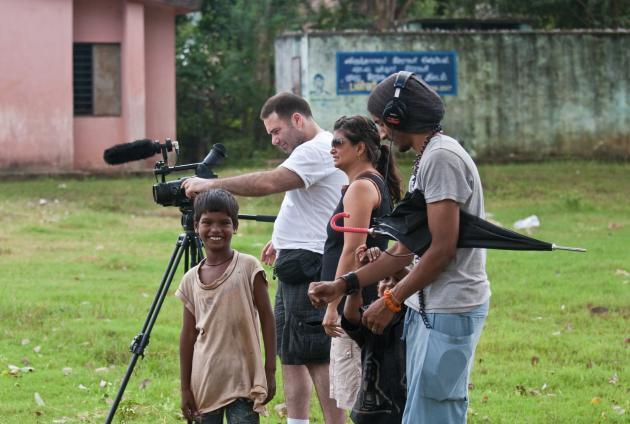
As far as where the film went, it was always intended to be a fundraising vehicle for Sankara Eye Foundation and that’s what it is today. It did however premier in 2013 at the South Asian International Film Festival (SAIFF). On a larger scale, it really established my second avatar and allowed me to be a documentary and film director.
I am actively seeking my next film/documentary project. I would love for it to be around women’s issues. I would love for it to be in another country, ideally India. One of my goals is to take 5-10 women from the US to a women’s collective in India and to be able to work with women who are recipients of a microfinance loan and are building their own business. I think they will stand to benefit as much from us as we would from them. So for now I am looking for that women’s collective that I could bring everyone to.
What was your inspiration behind launching ‘Lady Drinks’ – a networking platform for South Asian women? In what ways do you empower women entrepreneurs?
Greta, my production partner, had started Lady Drinks in Toronto. It was started in Toronto in response to the recession. In its original incarnation, it was a monthly networking event for women in TV and film to network and get jobs. She proposed the idea of starting Lady Drinks in New York and I said, “sure”.
What I didn’t expect when we started hosting events in July 2012, that some 300 South Asian girls would start showing up. It was the very first time, I guess, that I had been taken down from behind the glass screen of the television and made accessible. In the last 15 years, a whole generation of South Asian girl had grown up watching me. I had always been very unabashedly vocal about my story. Now all of these women were coming to share that they too were doing something outside the traditional Indian purview of ‘doctor, lawyer, and engineer’.
Today, Lady Drinks champions the South Asian female entrepreneur. The business model is, I host an event every month, thereby creating a platform where like-minded women come together. You can chat, meet, network, build best practices and realize synergies. We are now in year 3 and ramping up to more than one event a month. Each month is different. I might have a workshop, a speaker, a panel discussion. We recently went to the opening night of Nirbhaya, which centers on Gender Based Violence in India. In May, I’m moderating a panel with the heads of marketing for Google, Pinterest and Facebook.
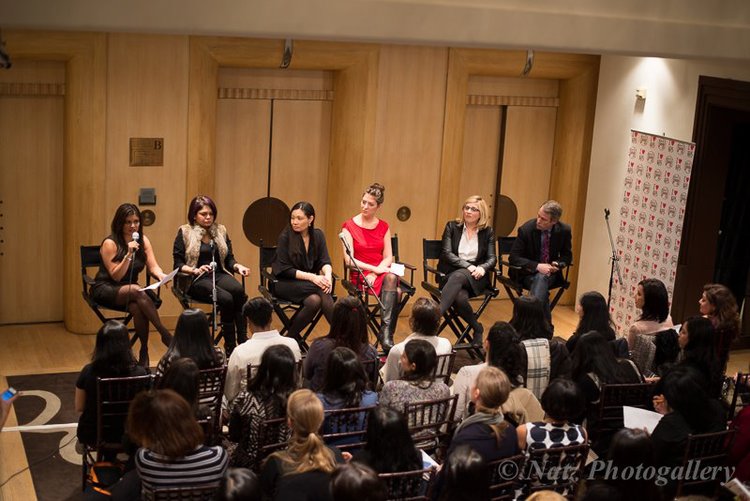
Success stories – I did a screening of Girl Rising and afterwards I brought in the heads of four different women focused charities. One of my members went on to become a board member of Hollaback! People have gone in to do trunk shows together. They just happen to find somebody who is on the same wavelength as them.
Being effective presenter is critical for anyone who is (or aspired to be) in a leadership position. What is the true secret to effective public speaking? How do you keep the audience engaged?
Take an improv class, its one of the best exercises in confidence booster. It teaches you to think on your feet. For me, I really learnt on the job. That was from doing it every day, several times a day. But for someone who doesn’t have access to that experience, an improv class is a great place to start.
It doesn’t matter what you are talking about, when you say it with confidence that’s 50% of it. I still get jitters speaking in front of a crowd, because a camera doesn’t react but a crowd does. Figuring out ways to engage everybody that comes from my passions, my confidence and also a lot of practice.
It’s important to have fun no matter what you are doing. So injecting a sense of humor and being willing to be vulnerable and authentic. You don’t have to be the best speaker in the world, but if you are speaking from a place of truth, people will know. Everybody has a story. When I gave my TED talk it was months of practice with my storytelling coach to distill that story down to the 15 minutes that it is today.
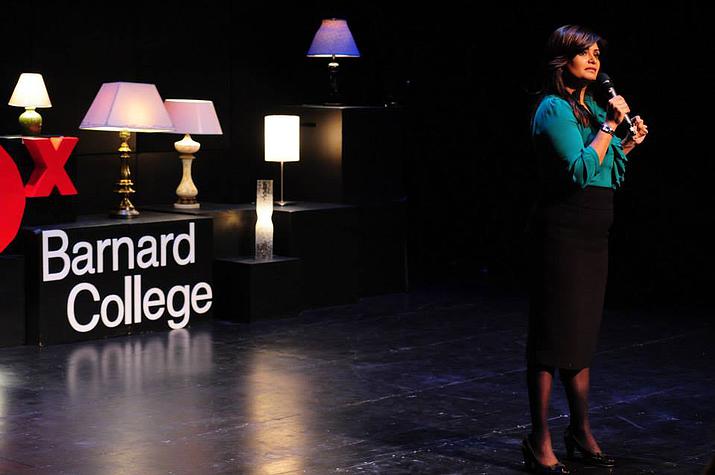
If you don’t have the resources, videotape yourself. Everyone now has a smart phone, use it to tape yourself and playback and see what is interesting or not to you. When I was editing my film, every two-weeks I would have my professional friends come to my living room and I would show them the film and ask them what’s working for them? You can create a little focus group with your friends, parents etc. If speaking is something you want to do, that automatic feedback is so important.
Everything in the way of technology is available at the consumer level. You can just play back and critique yourself or ask someone else to critique you. It’s hard to see the waters that you swim in sometimes, so an outside opinion can help.
What is your idea of an empowered woman?
An empowered woman is somebody who is unapologetic about their mission and what they want in life. I don’t care if it’s making shoelaces. They do it with a certain level of integrity and passion and they don’t feel like they have to apologize about it to anybody about that being what occupies most of their time. I think it’s somebody who pulls others up with them and sees that they have leadership qualities and empowers them to be able to help others and move forward in a critical way.
Sayfty’s mission is to Educate, Equip and Empower women so that they can protect themselves against violence. What is your message for our readers related to women’s personal safety and the issue of violence against women.
For a long time, I did not have a voice or a blueprint on how to express myself gracefully until I took that a women’s empowerment class. And during International women’s week I got to preside and moderate a new curriculum that the World Association of Girls Guide and Girls Scout (WAGGGS) is implementing in schools. The first step of this non-formal curriculum is to teach girls the language and process by which to identify that they have been bullied, cyber-bullied, harassed or compromised in any way, and then, to be able to articulate that to a parent or a teacher. I feel like a lot of the damage starts right there by not being able to do point one or point two. And so if you haven’t told anybody or haven’t identified that you have been compromised in some way then how in the world are you going to take action, which is step 3.
And it doesn’t matter if you are in India or here in the US, you have to build around you that group that’s going to be supportive and thinks the way that you do and it’s a matter of going and actively seeking them out. And those people may not necessarily be at home, for me those people were not at home, they were elsewhere.
Bio
Joya Dass is an American TV anchor, living and working in New York City. Joya Dass was one of the first South Asian females to be seen on mainstream television in the US. She’s been a business anchor for major networks for the last 15 years, including CNN, ABC and Bloomberg. She can currently be seen delivering live hourly reports from the floor of the New York Stock Exchange (NYSE) for NY1 News. She has also been the host of a popular Saturday morning entertainment show AVS since December 2002.
Joya is currently using her 15 years in television production to support her women’s networking initiative called Lady Drinks, which champions the South Asian female entrepreneur. Lady Drinks hosts monthly events designed to support the female small business entrepreneur.
Under the Joya Dass Productions umbrella, she has produced and directed a series of social justice documentaries and photo essays. In 2014, Joya was named the Executive Director of the South Asian International Film Festival, presented by HBO.
Joya is a frequent speaker, emcee and moderator. Her sharp interviewing skills and on-air snarkiness come across in her live engagements. Joya delivered her first TED Talk on the topic of ‘Re-thinking Failure’ at Barnard College on November 2nd, 2013.
